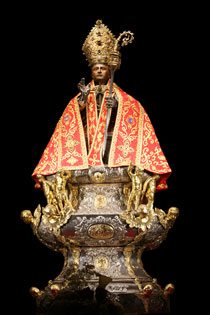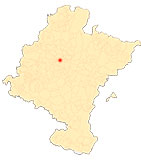Treasure of San Fermín
By Ignacio Miguéliz Valcarlos
Image of San Fermín
The image of San Fermín is a half-length polychrome wood carving from the end of the 15th century. It is a reliquary image, as its chest contains an oval teak containing various relics of the saint brought from Amiens. Over the centuries, the carving was enriched with silver-plated additions. Thus, in 1572, the Olite silversmith Hernando de Oñate el Mayor made a silver reliquary to be placed on the chest, consisting of a cartouche of cardboard and twisted leather, as attested by the author's mark on the same Hº/OÑATE. Subsequently, in 1687, the image of the Saint was clothed with a silver mantle or rain cloak, at a cost of 1,936 reales, which was paid for by the Pamplona regiment, hidden under the cloth cloak that he usually wears, articulated by means of eight pieces that are joined together, with floral decoration. And finally, in 1746, also at the request of the city council, the silver pedestal with gilded additions, on which the saint stands, was made. Designed by the Zaragozan silversmith and engraver Carlos Casanova and carved by the Pamplona craftsman Antonio Ripando, it is articulated by means of a trapezoidal base on which sits a succession of concave and convex bodies with a rich decoration of plant elements framed on the fronts by oval cartouches with the coat of arms of Pamplona, in the lower and upper bodies, and scenes from the life of San Fermín in the middle. In the corners of the base, of profilemixtilinear, there are angels and cherubs cast in gilded metal, which are the result of a later addition, and break up and disfigure the structure of the piece.
The image of San Fermín usually carries a crosier and mitre of gilded silver and gemstones. The former is the work of Hernando de Oñate el Mayor, the same artist who made the reliquary on the chest, as we can see from the mark punched on it. It is made up of a cylindrical rod on which the macolla rests, in the form of a hexagonal shrine, articulated on the fronts by niches that house the figures of the Apostles: Saint Paul, Saint Bartholomew, Saint Andrew, Saint Simon, Saint James the Greater and Saint James Alpheus, separated from each other on the edges by vegetal ribs that run vertically along the entire structure of the shrine, altering its architectural lines. The head of the crozier, in the form of a volute with vegetal decoration, is part of the macolla, framing the figure of a shepherd on the thread, with six sheep on the outside of it, alluding to the bishop's work as shepherd of the flock of the faithful. The mitre is made of gilded brass and rhinestones, made in the 18th century, with a variegated decoration of vegetal elements that cover it completely, with a crest of fleur-de-lis on the profiles.
-
ANDUEZA UNANUA, P., La arquitectura señorial de Pamplona en el siglo XVIII. Familia, urbanismo y ciudad, Pamplona, Government of Navarre, 2004.
-
ARBETETA MIRA, L., "Cadena y cruz pectoral del tesoro de San Fermín", in ARRAIZA FRAUCA, J., San Fermín patrono, Pamplona, Pamplona City Council, 1989.
-
ARRAIZA FRAUCA, J., San Fermín. El santo, la devoción, la fiesta, Pamplona, Pamplona City Council, 2002.
-
GARCÍA GAINZA, M. C., and others, Catalog Monumental de Navarra. V***. Merindad de Pamplona, Pamplona, Government of Navarre-Archbishopric of Pamplona-University of Navarre, 1997.
-
HEREDIA MORENO, M.C., "Ejemplos de mecenazgo indiano en la capilla de San Fermín de Pamplona", in yearbook de programs of study Americanos, Tomo XLVI, 1989.
-
HEREDIA MORENO, M.C., "Bandejas y jarras del tesoro de San Fermín", in GARCÍA GAINZA, M.C., and FERNÁNDEZ GRACIA, R., (coords.), Juan de Goyeneche y el triunfo de los navarros en la monarquía hispánica del siglo XVIII, Pamplona, Fundación Caja Navarra, 2005.
-
HEREDIA MORENO, M. C., ORBE SIVATTE, M., and ORBE SIVATTE, A., Arte hispanoamericano en Navarra. Plata, pintura y escultura, Pamplona, Government of Navarre, 1992.
-
MIGUÉLIZ VALCARLOS, I., "El tesoro de San Fermín: Donación de alhajas al Santo a lo largo del siglo XVIII", in Promoción y Mecenazgo del Arte en Navarra. Cuadernos de la Chair de Patrimonio y Arte Navarro, nº 2, Pamplona, Chair de Patrimonio y Arte Navarro, 2007.
-
MIGUÉLIZ VALCARLOS, I., "Sacras con los patronos de Navarra y Pamplona", in FERNÁNDEZ GRACIA, R. (coord.), Pamplona y San Cernín 1611-2011. IV Centenary of the city's vow, Pamplona, 2011.
-
MOLINS MUGUETA, J.L., Capilla de San Fermín en la iglesia de San Lorenzo de Pamplona, Pamplona, Diputación Foral de Navarra, 1974.
-
MOLINS MUGUETA, J.L., "La mitra y báculo dieciochescos de San Fermín", in Diario de Navarra. Extraordinary of San Fermín, Pamplona, 1984.
-
MOLINS MUGUETA, J.L., "Mitra y báculo de San Fermín", in MORALES, A. J., Filipinas, puerta de Oriente: de Legazpi a Malaspina, Barcelona, SEACEX, 2003.
-
MOLINS MUGUETA, J.L., "Mitra y báculo del tesoro de San Fermín", in GARCÍA GAINZA, M. C., and FERNÁNDEZ GRACIA, R., (coords.), Juan de Goyeneche y el triunfo de los navarros en la monarquía hispánica del siglo XVIII, Pamplona, Fundación Caja Navarra, 2005.
-
ORBE SIVATTE, A., Platería del reino de Navarra en el siglo del Renacimiento, Pamplona, Government of Navarre, 2000.
-
ORBE SIVATTE, M., Platería en el taller de Pamplona en los siglos del barroco, Pamplona, Government of Navarre, 2008.












